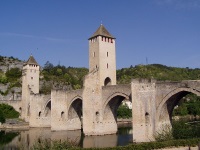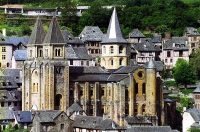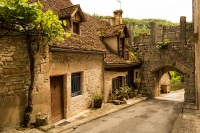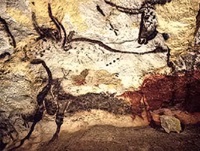Things to do in Dordogne and Lot
Attractions in Dordogne and Lot revolve mainly around the area's many lovely and historic villages. The medieval towns of Cohors, Conques and Montauban are remarkable and the stone villages of Domme and La Roque Gageac will captivate all who set foot in them. The most spectacular, however, is Rocamadour, which has been a pilgrimage site since the 8th century and has possibly the most breathtaking setting of any town in Europe. This cliffside town is fascinating and is one of the region's greatest treasures.
Visitors can easily do a tour of Dordogne and Lot centred only on châteaux, as there are so many exciting castles scattered about. Some of the best are the Château de Castelnaud, which houses a wonderful museum of medieval warfare; the Château de Commarque, a ruined 12th-century chateau with caves containing evidence of prehistoric man; and the Château de Beynac, an impressive castle perched above the restored medieval town of Beynac and commanding beautiful views over the river. The Château de Marqueyssac pales in comparison to these fortresses but has gorgeous gardens and cliffside walks.
Dordogne is one of the richest areas in the world in terms of ancient sites and evidence of prehistoric man. The famous painted caves of Lascaux are regrettably no longer open to the public, but there are equally impressive sites to explore, including the incredible Cave of Font-de-Gaume, which is a UNESCO World Heritage Site.

Cahors
Situated 55 miles (89km) north of Toulouse, in a loop of the Lot River, the ancient city of Cahors was inhabited long before the Romans arrived, and in medieval times was a thrivin…
Cahors
Situated 55 miles (89km) north of Toulouse, in a loop of the Lot River, the ancient city of Cahors was inhabited long before the Romans arrived, and in medieval times was a thriving university town. Across the river is the town's signature piece, the Pont Valentré. This magnificent fortified bridge was built between 1308 and 1500 and features a trio of towers, battlements and seven pointed arches. The Cathédrale St-Etienne dominates the old town and features a Romanesque north portal, which was carved around 1135.
Today the town is best known for its excellent cuisine and the fine deep red wine that is made in the surrounding vineyards. Sunday is market day and a good opportunity to buy some of the local produce. A good excursion from Cahors is the stunning cliff-edge village of St-Cirq-Lapopie, 19 miles (31km) to the east. Perched high above the south bank of the Lot, the village, with its cobbled lanes, half-timbered houses and gardens, is best visited in the evenings when the tour buses have left and the excellent restaurants have more tables available to linger over.
Montauban
Montauban lies on the banks of the River Tarn, 50 miles (80km) north of Toulouse, and is one of the most ancient cities in southwest France. Its origins date from 1144 when the Cou…
Montauban
Montauban lies on the banks of the River Tarn, 50 miles (80km) north of Toulouse, and is one of the most ancient cities in southwest France. Its origins date from 1144 when the Count of Toulouse decided to create a bastide here as a bulwark against English and French royal power. The genius of the original medieval town plan is still obvious in the lovely town centre and, although the suburbs now sprawl way beyond the old core, the city is still dominated by the fortified Eglise St-Jacques fort and the 14th-century brick bridge, Pont Vieux.
Montauban has a very attractive old town square and many of its buildings are constructed out of the red brick, typical for the region, which makes these old houses appear delightfully pink. The artist Jean-Auguste-Dominique Ingres (1780 to 1867) was born in Montauban and many of his works now hang in Musée Ingres, situated in the 17th-century Bishops Palace. The works collected here include the famous Dream of Ossian originally intended for Napoleon's bedroom in Rome. Apart from this art museum there are two religious monuments worth visiting in Montauban: the 13th-century Church of Saint Jacques; and the Cathedral of Notre-Dame, built in 1739 in the Baroque style.

Conques
Conques occupies a spectacular position on the flanks of the steep, densely wooded gorge of the little River Dourdou, a tributary of the Lot, and is one of the great villages of so…
Conques
Conques occupies a spectacular position on the flanks of the steep, densely wooded gorge of the little River Dourdou, a tributary of the Lot, and is one of the great villages of southwest France. The site was chosen as a retreat by a hermit called Dadon in the 7th century, and was named from the Latin concha, meaning shell.
Dadon founded a community of Benedictine monks here, one of whom pilfered the relics of the martyred girl, Ste Foy, from the monastery at Agen. Known for her ability to cure blindness and liberate captives, Ste Foy's presence brought pilgrims flocking to Conques and the magnificent Romanesque abbey-church became a prime stop on the pilgrimage route to Compostela in Spain.
Pilgrims still come today, along with tourists who come to admire Conques' beautiful setting. Conques is renowned to be one of the most beautiful villages in France and parts of the original town walls and gates survive, sealing in the narrow, cobbled village streets and the picturesque medieval houses spread out across the hillside. Conques Abbey was built between the 10th and 12th centuries, and the church and cloisters are truly impressive. The tympanum (carving above the main doorway) of the Last Judgement in the abbey is considered a masterpiece of 12th-century art.

Rocamadour
Tiered precariously halfway up a cliffside above a small river, Rocamadour has one of the most unique and breathtaking settings of any town in Europe. The town is famed for being t…
Rocamadour
Tiered precariously halfway up a cliffside above a small river, Rocamadour has one of the most unique and breathtaking settings of any town in Europe. The town is famed for being the site where the body of Saint Amadour (who is believed to be Zacchaeus of the Bible) was discovered, an event that led to a succession of miracles in the town. Since the 8th century it has been an important pilgrimage site; everyone from prince to pauper has ventured here in the hope of curing their ailments at the shrine. Unfortunately, the famous reliquary of the shrine has been plundered several times so that today it bears little relation to the original; however, many still testify to the spiritual significance and healing power of the place.
Today the town is overrun by tourists and its atmosphere has suffered accordingly, but, despite this, it is a must-see for the stunning views of the Dordogne and its marvellous situation. The town has magnificent ancient architecture, with many of the buildings cut directly into the rock of the cliffs, and is gloriously picturesque. Balloon rides are a popular way to see the area. The seven sanctuaries that make up the pilgrimage site are truly wondrous to behold. Visitors shouldn't miss the famous Black Madonna, thought to have been carved in the 11th century, which can be found in the Chapelle Notre Dame, a small Gothic chapel built in 1479.

Les Eyzies
In 1868 prehistoric skeletons were discovered in the Vézère valley, and the area was found to be one of the richest in the world in terms of ancient sites and deposits. The small…
Les Eyzies
In 1868 prehistoric skeletons were discovered in the Vézère valley, and the area was found to be one of the richest in the world in terms of ancient sites and deposits. The small market town of Les Eyzies suddenly became the base for exploring this treasure-trove of antiquities, including the many prehistoric painted caves.
The most famous and beautiful of these sites is at Lascaux, discovered by accident in 1940 by boys looking for their dog. The paintings were made about 30,000 years ago and depict wild boar, deer and majestic bulls. Unfortunately visitors cannot view the actual paintings anymore because the caves have been closed to the general public to prevent deterioration, but a replica gives visitors a clear picture of the remarkable works.
Travellers can still enter the incredible Cave of Font-de-Gaume and see the original rock art in this UNESCO World Heritage Site. The town has some excellent museums in which prehistoric art and artefacts are on display. Be sure to visit the Chateau de Commarque, a truly remarkable site boasting the ruins of a 12th-century chateau and caves containing prehistoric artefacts and paintings.



